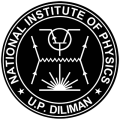Theoretically, light may be traveling slower than we thought. Dr. Nathaniel Hermosa II with his student Mr. Nestor D. Bareza, Jr. is able to show that the group velocity of a beam of light propagating helically to be slower than a plane wave speed c in a paper [1]. Both are faculty members of the Institute.
Light has always been assumed to be emanating at exactly the speed limit c (3×108 m/s) in free space. This fact has been the fundamental foundation of Einstein’s special relativity and in the formulation of Maxwell’s electromagnetic wave. The speed of light c in free space is always constant for a plane wave. A plane wave’s wavevector points purely along the direction of propagation axis. However, this has to carry infinite energy since plane waves are theoretically of infinite in extent, thus making plane waves physically unrealizable. Physical light beams, beams that propagate naturally, always have transverse wavevector components causing a delay in the speed even in free space.
In this Scientific Reports paper, the subluminal speed in free space of Laguerre-Gaussian (LG) beam was calculated. LG beams is commonly known to carry orbital angular momentum (OAM). Figure 1 (see attached Summary) depicts the helical wavefront of OAM-carrying beam. Such beams have transverse wavevector consisting of both radial and azimuthal components. This means that the energy of this beam upon propagation follows a helical trajectory. The presence of non-axial wavevector components induces an added path in the propagation of light, hence this results to delay in speed during propagation. This is the novelty of the research: the assertion that the group velocity is reduced when the propagation of energy of the beam of light follows a helical direction.
The results are important because: 1) all physical light travels as modes and that the researchers have shown that modes do not travel with the speed of light even in free space; 2) that information can be slowed by adjusting the internal energy flow of the beam; and 3) that the information embedded in these modes will not arrive at the same time.
Their theoretical findings reveal that LG beams could be traveling slower than the plane waves and may even be dispersive in free space. Their work also suggests necessary corrections in LG beam’s practical uses, especially in its far-travel-range applications such as data transmission in free space and data treatment from astronomical sources.
- [1] Bareza, N. D. and Hermosa, N. Subluminal group velocity and dispersion of Laguerre-Gauss beams in free space. Sci. Rep. 6, 26842; doi: 10.1038/srep26842 (2016).
- Summary file download link.
Article by: Nathaniel P. Hermosa, II
Contact information:
nhermosa@nip.upd.edu.ph
